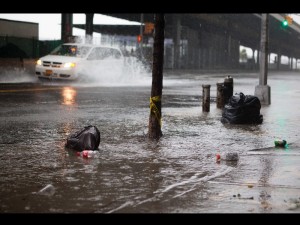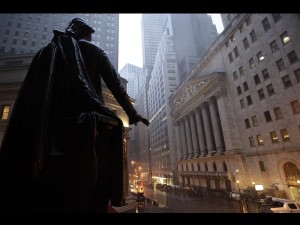Damage from Irene appears to be less than feared

LOOKS LIKE EDSA? Seawater surged into the streets of downtown Manhattan on Sunday, Aug. 28, 2011, as Tropical Storm Irene slammed into New York, downgraded from a hurricane, but still unleashing furious wind and rain. The flooding threatened Wall Street and the heart of the global financial network. AP/John Minchillo
WASHINGTON — Tropical Storm Irene’s trek up the East Coast caused less damage than many had feared, a bit of reassuring news for a fragile economy.
Insured damages from the storm will likely range between $2 billion and $3 billion, and total losses will likely be about $7 billion, according to preliminary estimates from Kinetic Analysis Corp., a consulting firm.
Both figures are lower than had been expected, suggesting that the storm poses little threat to the nation’s $14 trillion economy. Some economists said that, as with past hurricanes and earthquakes, the recovery could end up boosting growth in the coming months. Demand for building repairs might help the depressed construction industry, for example.
“Irene left several places with black eyes, but it doesn’t seem to have delivered an economic knockout,” said Ryan Sweet, an economist at Moody’s Analytics.
In the short run, the costs will grow as storm-ravaged areas deal with lost business, dislocated workers and transportation delays — damage that will take months to understand. And in some areas, the impact will be measured in lost tourist dollars, canceled flights and shuttered stores.
Irene slammed into a region that’s vital to the economy’s health. The mid-Atlantic and New England account for about 16 percent of the nation’s economic output and about 14 percent of its workforce, Sweet said.
But Kinetic’s estimates suggest that Irene will have caused far less insured damage than the $6 billion the insurance industry paid out after Hurricane Isabel struck the East Coast in 2003. Other analysts agreed broadly with Kinetic’s early estimates, saying insured losses are unlikely to exceed $4 billion. Other consultants will release their own projections this week.
Sweet said small businesses on the North Carolina coast will likely lose two weekends of tourist activity, including the travel-heavy Labor Day weekend. Beach communities spanning the East Coast face the same threat.

SILENCED. New York Stock Exchange is shown early Sunday, Aug. 28, 2011, in New York. Hurricane Irene bore down on a dark and quiet New York early Sunday, bringing winds and rapidly rising seawater that threatened parts of the city. The rumble of the subway system was silenced for the first time in years, the city all but shut down for the strongest tropical lashing since the 1980s. AP Photo/Mary Altaffer
For ordinary people in hard-hit areas, Irene’s costs could run high. Victims of natural disasters often lack the insurance they need to recover their losses and return to work quickly, said Susan Voss, Iowa’s top insurance regulator and president of the National Association of Insurance Commissioners. People who lose homes can end up in temporary housing far from their homes and workplaces.
Many don’t realize that flood damage isn’t covered by standard homeowner’s insurance policies, Voss noted. A standard homeowner policy covers damage caused by wind or by rain through a damaged roof. A separate flood insurance policy would be needed to cover damage from rising water, such as from the storm surges unleashed by Irene.
Economists said that reconstruction from Irene could increase U.S. economic growth in the October-December quarter, though the benefits will be limited by the relatively slight damage the storm caused.
“This region is very highly insured, so a lot of money will start pouring in, and that should re-employ a lot of construction workers who are now out of work,” said Mark Zandi, chief economist at Moody’s Analytics. Zandi said. He said the benefits from rebuilding might extend into next year’s January-March quarter.
“That will put some people back to work, at least temporarily,” said David Kotok, chairman of Cumberland Advisors.
For now, power outages and flooding will close some businesses, costing workers pay and likely increasing some temporary layoffs. Transportation and shipping may also be disrupted. The length of the outages and the extent of public transportation problems in cities like New York will help determine the costs, analysts said.
Such disruptions will emerge in economic data starting this coming week, when the government reports how many people applied for unemployment benefits as the storm bore down on the Southeast. Economists expect a post-storm rise in applications.
One concern is that weak economic data, even if blamed on a natural disaster, could weigh on consumer confidence and make businesses reluctant to spend.
But major fixtures of the economy are already returning to normal. The New York Stock Exchange and NASDAQ are preparing to open Monday. Mayor Michael Bloomberg lifted an evacuation order for lower Manhattan as of 3 p.m. Sunday.
Airlines planned to resume some flights into and out of East Coast airports on Monday. Crews are already restoring power in Southern states hit by the storm and are starting work in the northeast.
And Irene will add only about 15 percent to insurers’ weather-related payouts this year, if the current cost estimates hold. Tornadoes, flooding and droughts in the Midwest and South have forced the industry to handle about $17 billion in weather-related claims this year.